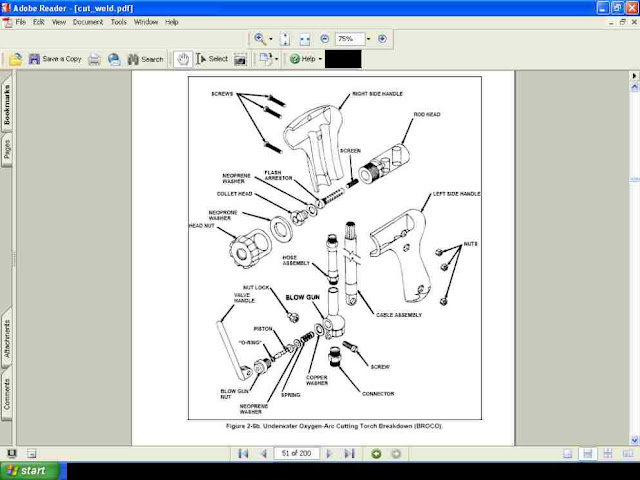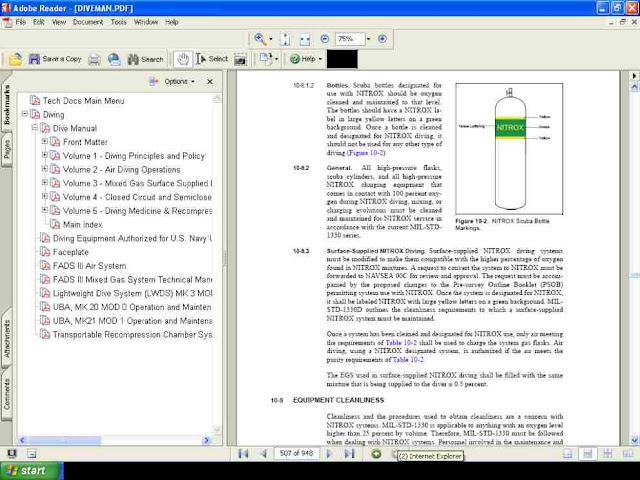


THE U.S. NAVY DIVING MANUAL
AND
THE U.S. NAVY UNDERWATER WELDING MANUAL



Nearly 1200 PAGES OF DIVING DIAGRAMS AND DATA! Don't confuse this manual with smaller ones...This one is the COMPLETE 1200 page version !
This Covers nearly ALL aspects of Recreational and Commercial Diving and offers a wealth of information from the true Pros of the Business
The U.S. Navy Diving Manual CD contains all 5 volumes covering Scuba, Air, Mixed Gas, Re-Breathers, Chamber Operations, Equipment, Dive Medicine, and all the Decompression Tables.
* WE SHIP WORLDWIDE TO: ENGLAND, SWEDEN, DENMARK, THE NETHERLANDS, CANADA, AUSTRALIA AND ALL OF EUROPE ! (see shipping rates below)

THE
U.S. Navy Underwater Welding and Cutting Manual
This CD contains:
TABLE OF CONTENTS
FOREWARD.......................................................................................................................
i
TABLE OF
CONTENTS...................................................................................................
iii
LIST OF
ILLUSTRATIONS.............................................................................................
ixv
LIST OF
TABLES.............................................................................................................
xi
STANDARD NAVY SYNTAX SUMMARY
................................................................ xiii
SAFETY
SUMMARY.......................................................................................................xvvv
CHAPTER (1).......... INTRODUCTION
1-1
SCOPE...........................................................................................................
1-1
1-2 UNDERWATER CUTTING
OVERVIEW................................................... 1-1
1-3 UNDERWATER WELDING OVERVIEW
................................................. 1-2
CHAPTER (2)..........UNDERWATER CUTTING
2-1 INTRODUCTION
.........................................................................................
2-1
2-2 OXYGEN-ARC CUTTING
.......................................................................... 2-2
2-2.1 Principles of Operation
..................................................................................
2-2
2-2.2 Steel-Tubular
Electrodes................................................................................
2-2
2-2.2.1 Advantages of the Steel-Tubular Electrodes
................................................. 2-5
2-2.2.2 Disadvantages of the Steel-Tubular
Electrode............................................... 2-5
2-2.3 Electrode Amperage Requirements
............................................................... 2-5
2-2.4 Oxygen
Requirements....................................................................................
2-6
2-2.5 Material Consumption
...................................................................................
2-6
2-2.6 Oxygen Pressure
............................................................................................
2-6
2-2.7 Oxygen Purity
..............................................................................................
2-11
2-2.8 Grounding the Work
....................................................................................
2-11
2-2.9 Steel-Tubular Electrode Cutting Technique (Thick plate)
.......................... 2-11
2-2.10 Steel-Tubular Electrode Cutting Technique (Thin plate)
............................ 2-15
2-2.11 Piercing Holes in Steel
Plate........................................................................
2-15
2-2.12 Steel-Tubular Electrode Cutting Technique (Cast Iron and Non-Ferrous
Metals)
.........................................................................................................
2-18
2-2.13 Post-dive
Maintenance.................................................................................
2-18
2-3 EXOTHERMIC
ELECTRODES................................................................. 2-22
2-3.1 Electrode Amperage Requirements
............................................................. 2-22
2-3.2 Oxygen
Requirements..................................................................................
2-25
2-3.3 Material Consumption
.................................................................................
2-25
2-3.4 Advantages and Disadvantages of the Exothermic Electrode Cutting Process
.........................................................................................................
2-25
2-3.4.1 Disadvantages of Exothermic Electrodes
.................................................... 2-27
2-3.5 Grounding the Work
....................................................................................
2-27
2-3.6 Exothermic Cutting Technique
.................................................................... 2-28
2-3.6.1 Exothermic Cutting Technique (Cast Iron, Stainless Steel and Non-Ferrous
Metals)....................................................................................
2-30
2-3.6.2 Exothermic Cutting Technique (Concrete, Rock and other Non-Conductive
Materials)
......................................................................... 2-31
2-3.6.3 Exothermic Hole
Piercing............................................................................
2-31
2-3.7 Trouble
Shooting..........................................................................................
2-31
2-3.7.1 Symptoms
....................................................................................................
2-31
2-3.7.2 Probable
Causes...........................................................................................
2-32
2-3.7.3 Locating and Solving the
Problem............................................................... 2-32
2-3.8 Post-Dive
Maintenance................................................................................
2-33
2-4 SEELER ENTERPRISES LU-001 EXOTHERMIC CUTTING TOOL (KERIE
CABLE)........................................................... 2-33
2-4.1 Advantages and Disadvantages of the of the Kerie
Cable........................... 2-34
2-4.2 Materials Required for Kerie Cable
Cutting................................................ 2-35
2-4.3 Equipment Set-up
........................................................................................
2-37
2-4.4 Kerie Cable
Preparation...............................................................................
2-39
2-4.5 Cutting
Underwater......................................................................................
2-39
2-4.6 Cutting
Technique........................................................................................
2-40
2-4.7 Cutting Thin Metals
.....................................................................................
2-40
2-4.8 Cutting Thick Metals
...................................................................................
2-41
2-4.9 Re-Lighting Cable
Underwater....................................................................
2-43
2-4.10 Emergency Off Safety
Procedures............................................................... 2-43
2-4.11 Loss of Communications
.............................................................................
2-43
2-4.12 Equipment
Tender........................................................................................
2-43
2-4.13 Electrical Precautions
..................................................................................
2-43
2-4.14 Post-Dive
Maintenance................................................................................
2-43
2-5 SHIELDED METAL ARC
CUTTING........................................................ 2-44
2-5.1 Principles of Operation
................................................................................
2-44
2-5.2 Materials
......................................................................................................
2-44
2-5.3 Waterproofing Electrodes
............................................................................
2-44
2-5.4 Underwater Shielded Metal-Arc Cutting
Techniques.................................. 2-45
2-5.5 Drag
Technique............................................................................................
2-46
2-6
CONCLUSION............................................................................................
2-46
CHAPTER (3).......... UNDERWATER WELDING
3-1 INTRODUCTION
.........................................................................................
3-1
3-2 MECHANICAL BARRIERS
........................................................................ 3-2
3-2.1 Cofferdams and
Caissons...............................................................................
3-2
3-2.2 Mini-Habitats
.................................................................................................
3-2
3-3 SHIELDED METAL-ARC WELDING
........................................................ 3-3
3-4 WET WELDING
...........................................................................................
3-3
3-5 SHIPBUILDING
MATERIALS....................................................................
3-3
3-6 MATERIALS USED IN UNDERWATER SHIELDED METAL-ARC
WELDING.....................................................................................................
3-6
3-6.1 Underwater Shielded Metal-Arc Welding Electrodes
................................... 3-6
3-6.2 Tong Test Ammeter
.......................................................................................
3-6
3-6.3 Electrode Polarity
..........................................................................................
3-6
3-7 UNDERWATER WELDING ARCS
............................................................ 3-8
3-8 CONDITIONS ADVERSE TO UNDERWATER WELDING..................... 3-8
3-9 STRENGTH OF UNDERWATER FILLET WELDS ................................ 3-10
3-9.1 Parts of a Weld (Definitions)
....................................................................... 3-10
3-9.2 Fillet Weld
...................................................................................................
3-12
3-9.3 Trial Weld
....................................................................................................
3-12
3-10 SURFACE
CLEANING..............................................................................
3-12
3-11 JOINT
FIT-UP.............................................................................................
3-13
3-12 UNDERWATER SHIELDED METAL-ARC WELDING TECHNIQUES
............................................................................................
3-13
3-12.1 Welding Set-Up
Procedures.........................................................................
3-13
3-12.2 Self-Consuming Technique
......................................................................... 3-14
3-12.3 Fillet Welding in the Horizontal Position (Self-Consuming Technique) ....
3-14
3-12.3.1 Fillet Welding in the Vertical Position
........................................................ 3-17
3-12.3.2 Fillet Welding in the Overhead
Position...................................................... 3-17
3-12.3.3 Self-Consuming and Manipulative
Techniques........................................... 3-20
3-12.3.4 Fillet Welding Where There is Poor Fit-Up
................................................ 3-20
3-12.4 Welding on Thin
Plates................................................................................
3-20
3-13 PROCEDURE FOR REPAIRING SMALL CRACKS............................... 3-22
3-13.1 Using a Rectangular Patch
........................................................................... 3-22
3-13.2 Using a Circular Patch
.................................................................................
3-22
3-14 POST-DIVE MAINTENANCE
.................................................................. 3-25
CHAPTER (4).......... UNDERWATER ARC CUTTING AND WELDING EQUIPMENT
4-1 INTRODUCTION
.........................................................................................
4-1
4-2 EQUIPMENT USED FOR UNDERWATER ARC CUTTING AND WELDING
...........................................................................................
4-1
4-2.1 Oxygen-Arc and Shielded Metal-Arc Equipment
......................................... 4-1
4-2.2 Diving
Equipment..........................................................................................
4-1
4-2.2.1 Welding
Shields.............................................................................................
4-1
4-2.3 Power Supply
Requirements..........................................................................
4-9
4-2.3.1 Power
Converters...........................................................................................
4-9
4-2.3.2 Welding Generator, Pre-Setup Inspection
................................................... 4-11
4-2.3.3
Polarity.........................................................................................................
4-11
4-2.3.4 Polarity test
..................................................................................................
4-11
4-2.3.5 Tong Test Ammeter
.....................................................................................
4-13
4-2.3.6 Amperage and Voltage
................................................................................
4-13
4-2.3.7 Diesel Driven Welding Generator Amperage and Voltage Settings
........... 4-15
4-2.4 Safety
Switches............................................................................................
4-16
4-2.5 Power Cables and Connectors
..................................................................... 4-16
4-2.6 Gas
Manifolds..............................................................................................
4-17
4-2.7 Underwater Oxygen-Arc Cutting
Torches................................................... 4-17
4-3 EQUIPMENT FOR UNDERWATER SHIELDED METAL-ARC WELDING
..................................................................................................
4-19
4-3.1 Electrode Holders
.......................................................................................
4-19
4-4 WELDING ACCESSORIES
....................................................................... 4-20
Appendix Page
DOCUMENTATION MATRIX
A-1
PURPOSE.....................................................................................................
A-1
A-2 REFERENCE
DOCUMENTS......................................................................
A-1
METRIC CONVERSION FACTORS
English and Metric Equivalents
.......................................................................................B-1
Weights
...................................................................................................................B-2
Measures
.................................................................................................................B-2
Pressure or Stress (Force/Area)
.......................................................................................B-3
Temperature
Conversion..................................................................................................B-3
Metric
Prefixes.................................................................................................................B-3
Multiplication
Factors......................................................................................................B-3
C
BIBLIOGRAPHY..........................................................................................................C-1<
br> D SAFETY IN UNDERWATER CUTTING AND WELDING
D-1
PURPOSE.....................................................................................................
D-1
D-2
GENERAL....................................................................................................
D-1
D-3 EXPLOSIVE
GASES...................................................................................
D-1
D-3.1 General
Information......................................................................................
D-2
D-3.2 Specific Information
.....................................................................................
D-2
D-4 ELECTRICITY
UNDERWATER................................................................ D-4
D-5 GENERAL PRECAUTIONS FOR UNDERWATER CUTTING AND
WELDING....................................................................................................
D-4
D-6 POWER
SUPPLY.........................................................................................
D-5
D-7 ELECTRODE HOLDERS AND CUTTING TORCHES ............................ D-6
D-8 POWER CABLES AND
CONNECTORS................................................... D-7
D-9 SAFETY
SWITCH.......................................................................................
D-8
D-10 FIRE AND EXPLOSION
PREVENTION................................................... D-9
D-10.1 Major Causes
..............................................................................................
D-10
D-11 COMPRESSED GAS SUPPLIES
.............................................................. D-10
D-11.1 Use, Handling and Storage of Compressed
Gases...................................... D-10
D-11.1.1 The Never List
............................................................................................
D-10
D-11.1.2 The Always
List..........................................................................................
D-11
D-11.1.3 General Oxygen Precautions
...................................................................... D-12
D-11.1.4 General MAPP Gas Precautions
................................................................. D-12
D-11.2 Additional Safety Precautions
.................................................................... D-13
D-12 PERSONAL SAFETY IN DIVING
........................................................... D-14
D-12.1 Diving Dress
...............................................................................................
D-14
D-13
CONCLUSION...........................................................................................
D-14
E EXCEPTIONAL SITUATIONS
E-1
PURPOSE......................................................................................................E-1
E-1.1
Discussion......................................................................................................E-1
E-1.2 Authorization
.................................................................................................E-1
E-2 UNDERWATER CUTTING
EQUIPMENT.................................................E-1
v E-2.1 Arcwater
Cutting............................................................................................E-1
E-2.2 Principles of Operation
..................................................................................E-2
E-2.3 Applications
...................................................................................................E-2
E-2.4 Necessary Equipment
....................................................................................E-2
E-2.4.1 Power
.............................................................................................................E-2
E.2.4.2
Water..............................................................................................................E-2
E-2.4.3 Arcwater torch
...............................................................................................E-2
E-2.4.4
Electrodes.......................................................................................................E-2
E-2.5 Arcwater Electrode Cutting Technique
.........................................................E-4
E-2.5.1 Underwater
Preparations................................................................................E-4
E-2.5.1.1 Cutting
...........................................................................................................E-4
E-2.5.1.2 Gouging
.........................................................................................................E-4
E-2.6 Material Consumption
...................................................................................E-5
E-2.7 Post-Dive
Maintenance..................................................................................E-5
E-3 CUTTING UNDERWATER WITH THERMIC LANCE (BURN
BARS)............................................................................................................E-5
E-3.1 Material Description
......................................................................................E-7
E-3.2 Required Equipment
......................................................................................E-8
E-3.3 Set Up Procedure
...........................................................................................E-8
E-3.4 Material Consumption
................................................................................
E-10
E-4 MAPP GAS
CUTTING...............................................................................E-10
E-4.1 Principles of Operation
................................................................................E-10
E-4.2 Equipment and
Material...............................................................................E-11
E-4.3 Protective Clothing
......................................................................................E-12
E-4.4 Cylinders and
Regulators.............................................................................E-12
E-4.4.1 Purging the Hoses
........................................................................................E-12
E-4.5 Underwater MAPP Gas Cutting
Torches.....................................................E-14
E-4.6 Igniting the Torch Above
Water..................................................................E-16
E-4.6.1 Preparation
...................................................................................................E-16
E-4.6.2
Ignition.........................................................................................................E-16
E-4.7 Lowering the Ignited Torch
.........................................................................E-18
E-4.8 Underwater
Cutting......................................................................................E-18
E-4.8.1 Starting the Cut at the Edge of a Plate
.........................................................E-18
E-4.8.2 Starting the Cut at the Central Portion of a
Plate.........................................E-18
E-4.8.3 Advancing the Cut
.......................................................................................E-21
E-5 UNDERWATER
WELDING......................................................................E-22
E-5.1 Waterproofing Surface
Electrodes...............................................................E-22
E-5.2 Preparation for Underwater Shielded Metal Arc Welding
..........................E-24
E-6 LOSS OF VOICE COMMUNICATIONS
..................................................E-26
E-7 FRICTION STUD
WELDER......................................................................E-26
E-7.1 Principle of
Operation..................................................................................E-26
E-7.2
Advantages...................................................................................................E-26
E-7.3 Equipment
Requirements.............................................................................E-27
E-7.3.1 Equipment
Details........................................................................................E-27
Glossary
.............................................................................................
Glossary-1
Index
.......................................................................................................
Index-1
LIST OF ILLUSTRATIONS
2-1 Underwater Oxygen-Arc Cutting
Electrodes...................................................................
2-3
2-2 Underwater Oxygen-Arc Electrode Designs
................................................................... 2-4
2-3 Drag Techniques for Cutting Steel with Steel-Tubular Electrodes
............................... 2-12
2-4 Technique for Cutting Steel Less Than 1/4 Inch with Steel-Tubular Electrodes
.......... 2-16
2-5 Technique for Piercing Holes in Steel Plate using the Oxy-Arc Process with
Steel Tubular
Electrodes................................................................................................
2-17
2-6a Underwater Oxygen-Arc Cutting Torch Breakdown (Arcair).......................................
2-19
2-6b Underwater Oxygen-Arc Cutting Torch Breakdown (BROCO)
................................... 2-20
2-6c Underwater Oxygen-Arc Cutting Torch Breakdown (Craftsweld)
............................... 2-21
2-7 Technique for Cutting Steel Using Exothermic Electrode
............................................ 2-29
2-8 Seeler Kerie Cable Control Panel
.................................................................................
2-36
2-9 Typical Kerie Cable Set Up
...........................................................................................
2-38
2-10 Technique for Underwater Shielded Metal-Arc Cutting of Thick Plate and
Round
Stock...................................................................................................................
2-47
3-1 Test Specimen for Tee Fillet Weld
..................................................................................
3-5
3-2 The Underwater Welding
Arc..........................................................................................
3-9
3-3 Parts of a
Weld...............................................................................................................
3-11
3-4 Self-Consuming Technique for Underwater Shielded Metal Arc Welding of
Horizontal Fillet Welds
.............................................................................................
3-16
3-5 Self-Consuming Technique for Underwater Shielded Metal Arc Welding of
Vertical Fillet
Welds..................................................................................................
3-18
3-6 Technique for Underwater Shielded Metal Arc Welding of Overhead Fillet
Welds....................................................................................................................
3-19
3-7 Feeding-In Technique for Underwater Shielded Metal Arc Welding of Fillet
Welds in Wide-Gap
Joints....................................................................................
3-21
3-8 Repair Method for Cracks in Underwater Structures Using a Rectangular
Patch......... 3-23
3-9 Repair Methods for Cracks in Underwater Structures Using a Circular
Patch.............. 3-24
3-10 A Typical Underwater Welding Electrode Holder
........................................................ 3-26
4-1 Typical Arrangement of Underwater Arc Cutting Equipment
........................................ 4-2
4-2 MK12 SSDS Welding Shield
..........................................................................................
4-3
4-3 MK1, MOD 0 Mask and Lens Holder Assembly
............................................................ 4-4
4-4 Superlite-17B/NS Helmet and Lens Holder Assembly
................................................... 4-5
4-5 MK 12 Helmet Lens Holder Assembly with Parts
Identification.................................... 4-6
4-6 Superlite-17B/NS Welding Lens Holder with Parts Identification
................................. 4-7
4-7 Typical Welding Generator and Power-Converter Control Panel
................................. 4-10
4-8 Equipment Arrangement for Welding and Cutting Straight Polarity
............................ 4-12
4-9 Tong Test Ammeter
.......................................................................................................
4-14v 4-10 Voltage Drop in Welding
Cables...................................................................................
4-18
E-1 Arcwater Torch Assembly
...............................................................................................E-3
E-2 Thermic Lance Holder Assembly
....................................................................................E-9
E-3 Standard Thermic Lance Equipment Set Up
...................................................................E-9
E-4 Standard Surface Cutting Torch with Underwater Spacer
Sleeve.................................E-15
E-5 Starting the Cut at the Edge of a Plate
...........................................................................E-19
E-6 Starting a Cut in the Central Portion of a
Plate..............................................................E-20
E-7 Restarting the Cut
..........................................................................................................E-21
E-8 Friction Stud
Welder......................................................................................................E-28
LIST OF TABLES
2-1 Cutting Amperage Requirements for Steel-Tubular Electrodes
...................................... 2-6
2-2 Oxygen Regulator Settings for Oxygen-Arc Cutting Electrodes (Hose Lengths 50
Foot and 200
Foot)......................................................................................................
2-7
2-3 Material Consumption using Steel-Tubular
Electrodes................................................. 2-10
2-4 Recommended Power Settings for Cable Length/Size for Ultrathermic Electrodes
....................................................................... 2-24
2-5 Exothermic Electrode Consumption Guide
................................................................... 2-26
2-6 Oxygen Regulator Settings for Kerie Cable Cutting
..................................................... 2-41
2-7 Kerie Cable Size/Metal to be cut
...................................................................................
2-42
2-8 Kerie Cable Oxygen and Cable Consumption Ratio
..................................................... 2-42
2-9 Material Requirements for Underwater Shielded Metal-Arc Cutting
........................... 2-45
3-1 Guide to Steels and Electrodes for Wet Welding
............................................................ 3-4
3-2 Electrodes for Underwater Shielded Metal Arc
Welding................................................ 3-7
3-3 Recommended Amperage Settings for Wet Welding to Depths of 50 Feet
.................... 3-7
4-1 Recommended Equipment for Underwater Arc Cutting and
Welding............................ 4-8
4-2 Equipment Load-out for Wet Cutting/Welding Operations
.......................................... 4-22
4-3 List of
Manufacturers.....................................................................................................
4-26
4-4 Parts Information
...........................................................................................................
4-28
A-1 Salvage Documentation Matrix
......................................................................................
A-2
E-1 Arcwater Operating Data Cutting Carbon Steel
..............................................................E-6
E-2 Equipment and Material Requirements for Underwater MAPP Gas Cutting
........................................................................................................E-11
E-3 Regulator Gauge Settings
..............................................................................................E-13
E-4 Recommended Cutting Tip Sizes
..................................................................................E-14
E-5 Recommended Pressure Settings and Hose Size Selection Chart
.................................E-17
E-6 Surface Welding Electrodes Suitable for Wet Welding
................................................E-23
E-7 Recommended Amperage Settings for Wet Welding to Depths of 50 FSW.................E-25
DON'T BE CONFUSED BY OTHER CD MANUALS!
LOW RESOLUTION Sample image From Adobe Acrobat Viewer (included on CD)
Actual CD images are higher resolution and clarity



.............................................................................